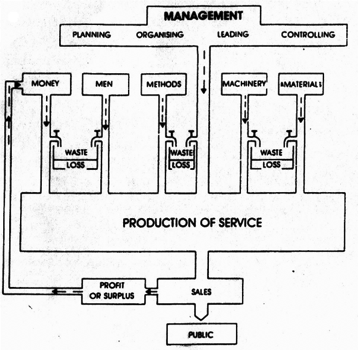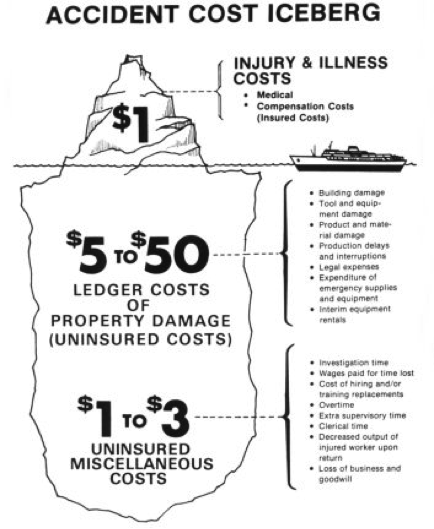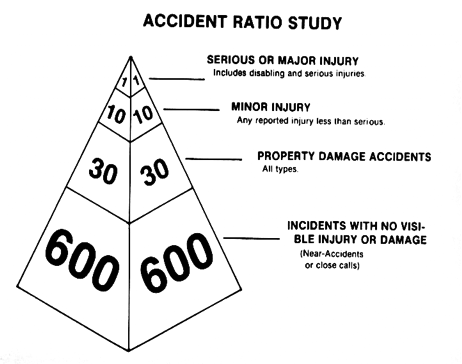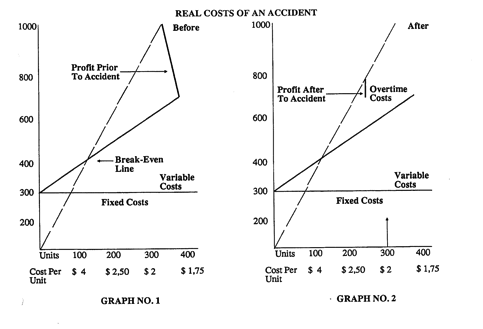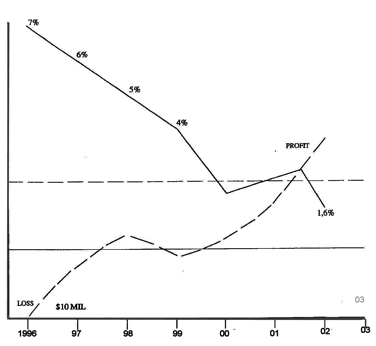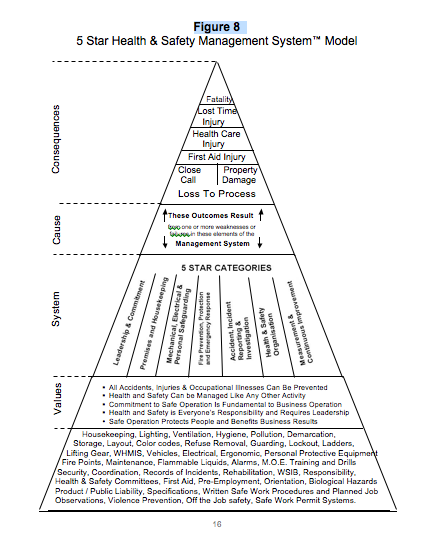 No other safety related activity could produce a status evaluation of any industrial or commercial enterprise better than a comprehensive audit. Performed professionally, audits provide management with answers based on facts, which in turn, generate appropriate solutions to problems. As safety professionals, it is our responsibility to ensure that we help managers ensure that their actions and activities within their mandate are based on facts.
No other safety related activity could produce a status evaluation of any industrial or commercial enterprise better than a comprehensive audit. Performed professionally, audits provide management with answers based on facts, which in turn, generate appropriate solutions to problems. As safety professionals, it is our responsibility to ensure that we help managers ensure that their actions and activities within their mandate are based on facts.
There are now many Health, Safety and Environmental Management System ‘models’ available, OHSAS18001, CSA’s Z1000. The ILO, the ISRS and our 5 Star Health & Safety Management System™ to name a few. One thing is certain, that there is no ‘one size fits all’ Occupational Health and Safety Management System, [OHS&E-MS]. An effective, quality driven OHS&E-MS is really measuring and verifying “conformance to requirements or standards”, without which, there can be no effective measurement or evaluation of performance.
INTRODUCTION
One of the greatest challenges facing management today is to conserve all human, physical and financial resources within their area of control. Many have realized that good management means making the best use of all available resources, and in addition, eliminating waste. One of the major waste-causing agents is the occurrence of accidents that result in death, injury, disease and costly damage to equipment, property and the environment. All of the foregoing invariably leads to production losses.
We developed a system when it was realized that virtually every accident prevention program, irrespective of the type of industry, consisted of certain basic elements. In other words, a checklist of key items could be made. Compliance with the list of items could then be determined. The list first generated in 1976 has grown over the years from the original 40 elements to the 2008 current edition which incorporates 78 items, which have been placed under 5 main headings for ease of use:
- Premises and Housekeeping.
- Mechanical, Electrical and Personal Safeguarding.
- Fire Prevention, Protection and Emergency Response.
- Accident Incident Recording and Investigation.
- Health and Safety Organization.
How Health and Safety Management System works and what it will do for management wishing to take up the challenge, will be discussed under the following headings:
- Management Principles.
- Management Leadership.
- Management Control System.
- Why Accidents Take Place.
- The Cost of Accidents.
- Management’s Financial Responsibilities.
- Management’s Legal Responsibilities.
- Management’s Moral Responsibilities.
MANAGEMENT PRINCIPLES
When managing a business enterprise or public institution, many responsibilities rest heavily on the shoulders of management, one of the most important being to make the enterprise viable. In order to do this; attention needs to be given to marketing, innovating productivity and the effective use of human, financial and physical resources. Invariably profit is the main motivation in most businesses, as yielding a profit spells survival and allows prediction of future business success or failure. In the case of governmental and service institutions, optimal service at least cost takes the place of profit.
Peter Drucker in his best selling book The Practice of Management makes the point that:
“Management must always in every decision and action put economic performance first. It can only justify its existence and its authority by the economical results it produces.”
Managing successfully falls under the headings of planning, organizing, leading and controlling. The successful manager will cause an interaction of the various components of the enterprise in order to reach the objective of the undertaking. The components may well be the familiar five M’s – the material, the money, the machinery, the methods and the manpower required to produce the products or service. These will be converted into a salable article and so in turn, result in a profit performance for the company. In carrying out the functions of planning, organizing, leading and efficiently controlling, with reference to materials, management has to ensure that the right quality and quantity of material is available at the right price and the right time. If these requirements are not met, then waste will take place. This in turn will result in loss, and must also affect the profit performance.
This concept is applicable to the other M’s in the chain of events, which lead to the objective of completing the task being reached [see Figure 1]. Therefore it stands to reason that in order to combine the five M’s effectively and efficiently, as much waste as humanly possible must be eliminated. The waste can be in the form of a deviation from the plan, or it can be in the form of incorrect labor, incorrect machines and incorrect methods. This can make all the difference between the relevant success of two companies, A and B, producing the same product in the same market and possibly at the same price. While Company A makes a profit by controlling waste, Company B makes a lesser profit, if not a loss, through failure to control waste. Despite the basic need to strive for optimum profits, many businesses face cuts into their profits on a daily basis. They do this through poor control of areas of waste such as damage to equipment, injury to people and fires.
Figure 1
FACTORS OF PRODUCTION
|
LEADERSHIP AND CONTROL FUNCTIONS
By identifying the key items or elements, which must be included in an effective health and safety management system, two important management principles are being followed – 1. Leadership and 2. Control. These principles are fundamental to the success of any program. The challenge to executive management is clear. Safety through leadership is far more fulfilling, more rewarding, more economical, and more democratic than safety by work group imposition, or indeed by government imposition. Initiative and positive leadership can control the erosion of freedom to manage. Our systems recognizes and incorporates this premise.
In order to carry out the leadership requirements, management needs to be convinced that an effective health & safety management system is simply a sound investment, which will produce very substantial financial rewards. In order to carry out the functions of management, in broad terms, management needs to appreciate the activities required to carry out the control function. It is necessary to plan, organize, lead and control. From the experience of Safety Projects International Inc. in conducting over 50,000 audits, the weakest link in the chain of management activities is the control function. Controlling is the function of determining the end result and process through which it will be reached. Observation of the activities scheduled within the process is essential, with timely corrections of variances where necessary. Effective management control involves the following actions:
The Identification of each of those key items, which economically and practicably can be controlled, such as the elements contained in our system. [It should be noted that it is not financially possible or feasible to control everything];
Our First Task is to Set Standards of Performance:
These should include the following components:
– What needs to be done?
– How often is it to be done?
– Who is to do it?
– Where is it to be done?
– What records are required?
– What reviews are required?
– What quality of product and performance is required?
Set Standards of Accountability: These must identify those people who have the responsibility to carry out the control of the identified items;
Measure against Standards: This requires the measurement of work in progress or performed, against the standards;
Evaluation: Any positive or negative deviation from the standard must be evaluated;
Commend or Correct: Good health & safety performance should always be recognized and commended. If necessary, correction to any deviation from the set standard should be made.
By evaluating management’s leadership efforts in taking up the challenge to reach the objectives set, it is possible to accurately determine the strengths and weaknesses in the existing health and safety management system.
Other recognized Management Principles pertinent to an effective health and safety program include the following:
- Principle of the Critical Few.
- Principle of Recognition.
- Principle of Participation.
Principle of the Critical Few: In any given group or array, a relatively small number of items will tend to give rise to the largest proportion of results.
This principle can relate to the cause and costs of loss, anatomical location of injury, occupation and job involvement, pieces of equipment, material or operators. Its application is so wide and its value so great in terms of time and effort conservation that it is considered one of the most important management principles.
One of the most useful applications of this principle is its use in arriving at the objectives which contribute to making a successful accident prevention program.
Principle of Recognition: Motivation to accomplish results tends to increase as people are given recognition for their contribution to those results.
The successful manager is the individual who can associate every facet of his/her program with a member of the team who assisted in promoting it. Application of personal and behavioral recognition serves as a powerful motivating force in reinforcing management and employee efforts. Recognition feeds the individual’s strong desire to feel they contributed, regardless of status or position.
Principle of Participation: Motivation to accomplish results tends to increase as people are given opportunities to participate in the decisions affecting those results.
Participation involves making a systematic provision for consultation with those involved in the safety management system. Acknowledgment of their suggestions, recommendations and advice create a sense of involvement and commitment. This is especially applicable when determining the priorities of the objectives that should be addressed first in establishing the system.
RECOGNITION FOR EFFORT AND ACHIEVEMENT
Bearing the above management leadership principles in mind, a further facet was added to our system – recognition. Realizing that people, by their nature, enjoy recognition, it was felt that by quantifying each of the items and by allocating marks could help set objectives or points and weighting those considered more important than others.
In our system, recognition, as a motivation for management and staff in meeting objectives, is given in the form of a star grading after an independent Safety Projects International audit.
This is awarded on the basis of 51% for the first star, 61% for the second, 71% for the third, 81% for the fourth and 91% for achieving the ultimate 5 star status.
Our approach has one further provision in that the visible, quantifiable effort made to reach the objective must result in a reduction of injuries, at this stage measured in terms of Disabling Injury Frequency Rate, [DIFR]. Admittedly this is not ideal, but by using the DIFR as well, offers a more balanced approach. For the financial and human resources spent on the safety program to be viable, there should initially be a reduction of injuries and then maintenance of low figures.
The stringent grading standards must then meet the following Disabling Injury Frequency Rate, (DIFR) requirement as well in addition to the audited star graded performance:
|
# Stars |
Grade |
Grading % |
DIFR |
|
5 |
Industry Leader |
91%+ |
1 or less |
|
4 |
Excellent |
81%+ |
2 |
|
3 |
Good |
71%+ |
3 |
|
2 |
Average |
61%+ |
4 |
|
1 |
Fair |
51%+ |
5 |
Why Do Accidents Take Place?
It is very important that any evaluation process be carried out in a specific manner and order. A safety program is, generally speaking, an abstract activity. It involves the action of giving good instructions, and seeing that those instructions are carried out. It is this abstract nature of a safety program, which can make it hard to ‘sell’ and introduce. Therefore, in order to be successful in selling any abstract idea, it is necessary to follow the golden rule of changing an abstract concept into a concrete one. For instance, it is necessary to physically investigate and evaluate the condition of equipment such as portable electric tools on the shop floor. Having determined any weaknesses, it is then possible to advise on the remedial measures, which will rectify the situation. An analogy would be in the case of the doctor, who needs a stethoscope to listen to the patient’s heart or chest to verify the symptoms observed. Only after this procedure can it be determined which remedial measures are required to rectify the situation. Therefore it is necessary to be physically present to observe and determine where the problem areas at plant level exist. By asking key questions of management and staff, an indication can be obtained of the procedures and attitudes regarding health and safety. Observations suggest weaknesses and strengths in the management control function. Armed with this knowledge, the systematic remedial measures that should be taken can be established.
As stated earlier, never before has there been a greater need to conserve valuable resources of people, equipment, materials and profit. One of the indicators of poor profit performance of a business is the number of accident/incidents it experiences. Safety Projects International Inc. [SPI] incorporates a system whereby a critical evaluation of the profit reducing areas caused by waste can be made. This assists management in meeting financial, legal and moral challenges of the future. The objective of the system is to determine where improved stewardship needs are required. In this way the most effective and balanced use of a company’s financial, physical and human resources is made using modern management methods.
The Cost of Accidents
The losses caused by business interruptions called ‘accidents’, are often estimated very conservatively and consideration needs to be given to the hidden “iceberg effects” [see Figure 2].
First Iceberg Effect
The costs arising out of accidents/incidents referred to previously, really only constitute a fraction of the total cost. There are many hidden costs which management erroneously believe do not effect their profit performance. There are two main types of cost, which arise after an accident takes place. These can be broadly classed as insured and uninsured, or hidden cost. The insured costs, which are covered by Workers Compensation, include medical attention, hospitalization, rehabilitation etc. It was stated back in 2002 that in Ontario the average lost time injury cost over $59,000.00. The average compensation claim cost over $11,771-00. However, those accidents which cause damage to plant or loss to the process, but that do not cause injury, are estimated to occur at a rate that is 5 to 50% more, and still people ask, “ Do accidents really affect profits?” Like all icebergs, the mass below the surface is the most dangerous. This is especially so when we consider what these hidden costs could add up to. Some writers maintain that the ratio of insured costs to hidden costs could be 1:4.
Second Iceberg Effect
If one iceberg were not enough to emphasize the very significant amount of avoidable waste that is taking place, there is a further iceberg. This relates to the frequency of injuries to the number of accidents / incidents which take place. From studies carried out in the UK; USA; Canada and South Africa, it was seen that there is a definite ratio between the various types of accidents.
A study carried out by my good friend, the late Frank Bird revealed the following ratios of accidents reported. For every one serious, or disabling injury reported, there were 10 injuries which required medical attention only; there were 30 property accidents of all types and there were a further 600 incidents with no visible injury or damage [Figure 3].
In referring to the 1/10/30/600 ratio it should be remembered that this represents the total number of accidents/incidents reported, not the number that actually occurred. The above ratio clearly indicates that it is foolish to direct efforts to the relatively few events that terminate in serious or disabling injury. The fact that there are 630 property damage, or no-loss accidents/ incidents for every 11 injuries, indicates that the total loss due to injuries accounts for less than 2%. Therefore, there is a much larger basis for more effective control of the total loss due to accidents.
Do Accidents/ Incidents Really Impact Profits?
In order to determine whether business interruptions, commonly called accidents/incidents, really have an effect on profits, a break-even chart explains the situation possibly better than any other method. When determining the production cost of a commodity, cognizance must be taken of the variable and fixed costs. The variable costs consist of basically the raw material, labor, packing materials, power and water. These costs vary in direct proportion to the number of units produced and in our example let us assume that the variable costs are $1-00 per unit. In consequence, if 100 units are made, the variable cost will be $100-00. In contrast, fixed costs do not vary in terms of output, but are incurred whether nil units or 400 units are made. These costs consist of: management salaries, taxes and depreciation. They are all a function of time, not output. In the example we have set the fixed cost of $300-00 a week.
If we look at the break even graph No. 1 set out in Figure 4 we will see in this simple example that the cost per unit reduces as the number of articles are produced increases [known as the economies of scale]. If we produce 400 articles they cost us $1-75 each, but if we produce only 300 articles they cost us $2-00 each. Selling them at $2-50 each, the profit is .75 cents a unit. If we produce 400 articles, but with the lower production [300], the profit drops to only 50 cents a piece. So in our example, if the company produces and sells 400 units a week, the profit is $300-00. But then it happens! The saw-blade” explodes” due to an overlooked crack. The saw bench is shattered and equipment and product are damaged. An accident has taken place and damage has resulted. Now two things happen:
[1] The output falls to 300 units for a week – according to our break-even graph #1. The cost price goes up to $2-00 and the profit falls.
[2] Overtime has to be worked to maintain the 300 units for the week. This will result in a higher variable cost of $1.25 and further reduction of profits to a mere $75-00 [see break even graph #2 also in figure 4]. A drop in profit from $300-00 to $75-00 a week cannot make any manager happy, let alone a shareholder. In fact it is debatable that the manager can call himself a professional when he has not optimized profits at all.
These concepts, naturally, are applicable to each and every interruption in the work process, which in turn is the result of some wasted activity or resource. Therefore without a doubt, every business interruption must affect profits. In fact, one invariably finds a definite correlation between profits and the DIFR of a company. A typical example of this is a case of a large steelworks that showed a profit improvement of $30 million with a drop from 35 to 8 or7%-1.6% [see figure 5]. One of the reasons for this is the fact that those elements, such as selection, training, correct tools, work methods and communications, which assist in running a business efficiently, also contribute to reducing accidents/incidents. The effects on the profit margin can be a real eye opener for management and the most convincing method is to present the following table [6]. Assuming an average profit on sales of 5%, it is necessary to sell an additional $1 million to cover the loss of only $50-000 through accidents.
Figure 6
Sales Required to Cover Losses
| Yearly | Profit Margin | ||||
| Incident | |||||
| Costs | 1% | 2% | 3% | 4% | 5% |
|
1,000 |
100,000 |
50,000 |
33,000 |
25,000 |
20,000 |
|
5,000 |
500,000 |
250,000 |
167,000 |
125,000 |
100,000 |
|
10,000 |
1,000,000 |
500,000 |
333,000 |
250,000 |
200,000 |
|
25,000 |
2,500,000 |
1,250,000 |
833,000 |
625,000 |
500,000 |
|
50,000 |
5,000,000 |
2,500,000 |
1,677,000 |
1,250,000 |
1,000,000 |
|
100,000 |
10,000,000 |
5,000,000 |
3,300,000 |
2,500,000 |
2,000,000 |
|
150,000 |
15,000,000 |
7,500,000 |
5,000,000 |
3,750,000 |
3,000,000 |
|
200,000 |
20,000,000 |
10,000,000 |
6,666,000 |
5,000,000 |
4,000,000 |
This table shows the dollars of sales required to pay for different amounts of costs for downgrading incidents; i.e., if an organization’s profit margin is 5%, it would be required to make sales of $500,000 to pay for $25,000 worth of incidents; with a 1% margin, $10,000,000 of sales would be necessary to pay for $1,000,000 of the costs involved with downgrading incidents.
It is necessary to sell an additional $1,667,000 of product to pay the cost of this $50-000 in annual losses from injury, damage, theft or fire, assuming an average profit on sales of 3%. The amount of sales required to pay for losses will vary with the profit margin.
“IN TIMES OF KEEN COMPETITION AND LOW PROFITS, LOSS PREVENTION MAY CONTRIBUTE MORE TO PROFITS THAN THE BEST SALES OUTLET.”
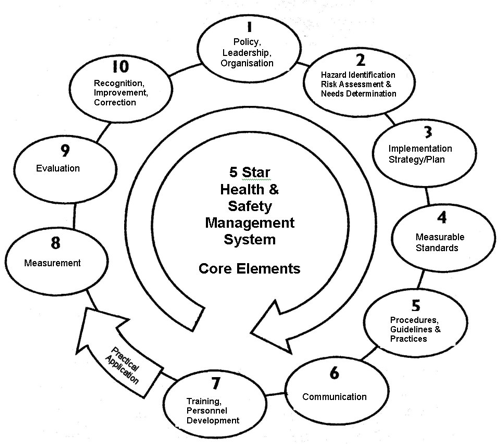 Management’s Legal Responsibilities.
Management’s Legal Responsibilities.
Most managers are aware that comprehensive rules and regulations are on the statute books, and that these place heavy responsibilities on their shoulders.
The legislation generally revolves around the following general duties:
- To provide a safe and healthy place of work.
- To provide safe systems of work.
- To provide safe access to and exit from their place of work.
- To provide adequate information, instruction and training and supervision.
- To provide and maintain safe plant, equipment and facilities.
To assist management in complying with their legal duties, management must make certain appointments in writing and ensure adequate training for performance of duties. In our experience few managers understand the legal language inherent in their position of responsibility. Therefore Safety Projects International prepared much of the documentation required to comply with the majority of International Laws, A systematic, planned approach to complying with these Acts and Regulations is incorporated.
Management’s Moral Responsibilities
The moral responsibilities resting on management’s shoulders concerning the workers, their families, and the public, are very real indeed. Many managers believe that workers compensation will meet all the costs involved. However, due to the income shortfall the employee may not be able to meet the financial commitments on the car, the mortgage and other credit repayments, His/her family may well have to suffer hardships.
Management By Leadership Requires Clear Objectives
It is not difficult to understand that the total prevention of all loss-producing events is neither economically feasible nor practical. It has been stated that the US space program proved that with an unlimited budget, an almost perfect safety system is possible, though not practical as the Challenger and Columbia space shuttles will confirm.
In both industry and government management must strive to optimize loss control effectiveness within the constraints of budget and available resources.
For all practical purposes, a program must be carefully planned to evolve at the fastest possible rate over a period of time, subject to the same business considerations involved in production, quality and cost improvement.
People by nature, are competitive, they like a challenge. The system incorporates components to meet this need, so that those involved in a program to improve the profit performance and reduce losses, will rise to meet the challenge.
Summary
In this paper it has been illustrated that the components of our system initially designed and developed in the 1970’s are based on the principles of sound management practices, and of course have been updated in order to keep pace with the new International standards and requirements such as OHSAS 18001 and CSA’s Z1000.
Throughout the audit process, objectives can be set with consultation and cooperation to actively involve all levels of management and staff. Monitoring the progress towards meeting objectives through the our Health and Safety Management System recognition process is an effective way to generate improvements necessary to avoid potential waste through accident/incidences and will ultimately have a positive impact on profit and performance.
Last year in Canada 85,000 people went out and bought quarter inch drills, none of them wanted a quarter inch drill, what they wanted was a quarter inch hole. In safety we spend far too much time looking for tools and not enough time using those we have. It is now time that we started boring the hole.
Bio:
Dr Bill Pomfret has over 40 years of experience in safety health and loss prevention, he is both founder and president of Safety Projects International Inc.
Educated in the UK, Bill has a Masters Degree in Occupational Safety and Health, a Doctorate of Education, is a Registered Safety Professional and a Fellow of the Institution of Occupational Safety and Health (UK)
Bill has conducted of OH&S audits in over40 countries using many of the better known health and safety management systems. Bill is a best selling author, speaker and video producer, and has appeared on TV and Radio interviews on many occasions.
Bill has received many honors for his safety work by the World Safety Organization where he was Exec Vice President for the Americas between 1975 and 1994, also by the National Safety Association of South Africa, also by the British Safety Council and the Indian Institute of Security and Safety Management where Bill was made an honorary life member.
Bill has been involved in some of the world’s biggest disasters, including Bhopal, the EXXON Valdez, Ocean Ranger and the Kuala Lumpur Airport Fire.
Dr. Pomfret can be reached at 26, Drysdale Street, Kanata, Ontario, Canada,
K2K 1X4. Tel: 613-2549233, Cellular: 613-8521354.
pomfretb@5star.com
or visit one of his websites at www.ICDC.ph or www.spi5star.com
